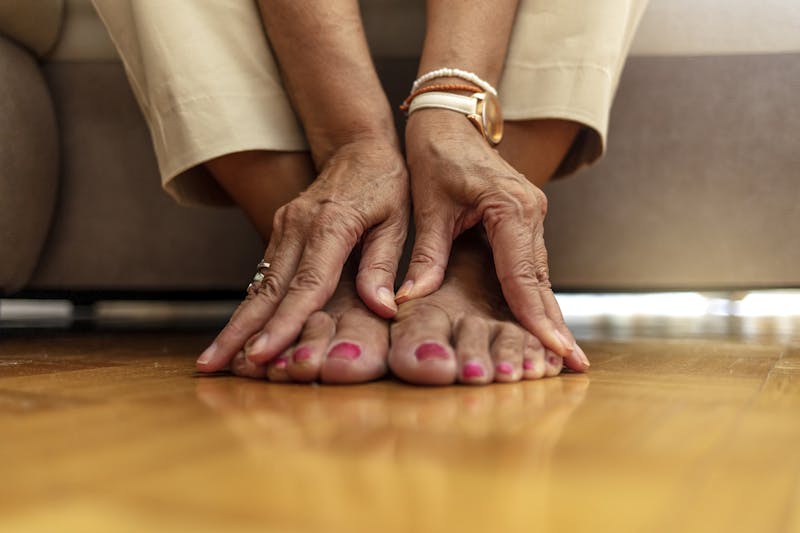
Diabetic ulcers are open sores that develop on the skin, typically on the leg or foot, though they can also happen on the hands or torso. Diabetic ulcers can be painful and take a long time to heal. About 15% of people with diabetes get them. In some cases, hospitalization is required due to infections or other complications. If severe, amputation of the affected limb is sometimes necessary. In order to assess the type of care needed, medical professionals rely on the classification of diabetic ulcer stages.
How Diabetic Ulcers Happen
When diabetes is poorly managed or left untreated, high blood sugar levels damage nerve cells and veins. Nerve damage may cause numbness in the extremities and make it difficult to feel an injury, which is how minor abrasions can become ulcers. Additionally, the restricted blood flow caused by vein damage means that cuts and sores, which rely on healthy circulation to heal properly, take an inordinately long time to improve.
How to Recognize a Diabetic Ulcer
Open wounds are the clearest indication that there may be a diabetic ulcer. The wound may be leaking fluid or have an odor. There may be swelling, discoloration/redness, or other irritation of the area. The wound may be painful, and there may be firmness along the wound. In extreme cases, there might be black tissues around the wound or gangrene. In cases like this, medical help should be sought immediately.
Diabetic Ulcer Stages
There are many different ways to classify ulcers, and each uses its own specific criteria. The University of Texas model and the Wagner-Meggitt model are the most common classification systems. There is no ‘right’ system that a medical facility should use, but it is essential for a patient’s care team to rely on the same system.
The University of Texas Diabetic Foot Ulcer Classification System
Medical professionals rely on a few different ways to identify the degree of a diabetic ulcer. The University of Texas Diabetic Foot Ulcer Classification System assesses ulcers based on depth and the presence or absence of infection and ischemia, which is the degree to which blood flow is restricted to an area. The grades are:
Grade 0 – Healed ulcer
Grade 1 – superficial ulcer not involving the tendon, capsule, or bone
Grade 2 – wound penetrating to tendon or capsule
Grade 3 – wound penetrating bone or joint
There are four stages within each wound grade:
Stage A – clean wounds
Stage B – non-ischemic infected wounds
Stage C – ischemic non-infected wounds
Stage D – ischemic infected wounds
The Wagner-Meggitt Diabetic Foot Ulcer Classification System
The Wagner-Meggitt Diabetic Foot Ulcer Classification System focuses on the depth of the ulcer. This system separates ulcers into six categories, ranging from fully intact skin to gangrenous. They are:
Stage 0 - No open lesions
Stage 1- Superficial ulcer (not yet at the deep layers of skin)
Stage 2 - Deep ulcer (reaches tendon, bone, or joint)
Stage 3 - Deep ulcer with abscess or osteomyelitis (swelling of the bone caused by infection)
Stage 4 - Partial gangrene
Stage 5 - Complete gangrene
Treatment
See a doctor immediately no matter the diabetic ulcer stage. The goal is to heal the wound as quickly as possible to prevent or allay infection. If there is no infection, a doctor will take steps to prevent one. They will clean and disinfect the area and remove dead skin and tissue (a process known as debridement).
Then they will apply a topical antibacterial medication and dress the ulcer in sterile bandages. The wound should be tended to daily until it heals completely, which may take several weeks or months. If the sore is on the foot, the patient will wear special foot gear and may need crutches or a wheelchair. At Wound Evolution, our expertly trained team will treat your wounds and develop a customized treatment plan to help you heal and prevent further injury.
Top-of-the-Line Care
The highly trained staff at Wound Evolution provides uncompromising care for all our patients. While diabetic ulcers are not uncommon, they require an accurate diagnosis from different types of ulcers and thorough care. At Wound Evolution, we take the time to listen to each patient’s medical history and conduct a comprehensive exam so we truly understand the problem and unearth any underlying problems that may exist in handling any of the diabetic ulcer stages.
We then create plans for each patient that are customized to their needs and lifestyle. We offer in-office or virtual appointments for your convenience. Our offices are located all over Texas, and we also have locations in Kansas and Arkansas.

